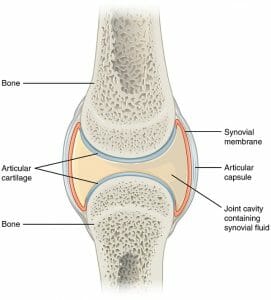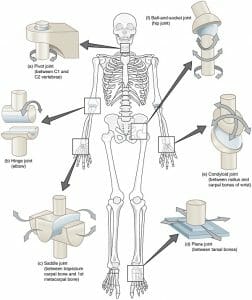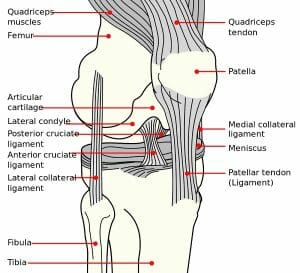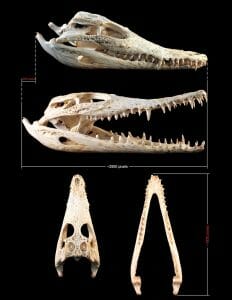Synovial Joint Definition
A synovial joint is a connection between two bones consisting of a cartilage lined cavity filled with fluid, which is known as a diarthrosis joint. Diarthrosis joints are the most flexible type of joint between bones, because the bones are not physically connected and can move more freely in relation to each other. In synarthrosis and amphiarthrosis connections between bones, the bones are directly connected with fibrous tissue or cartilage, limiting their ultimate range of motion.
Structure of a Synovial Joint
Although the exact structure of a synovial joint may vary depending on the function of the joint and the animal it is in, the general structure of each joint is the same. Extending from the periosteum of the bone, an articular capsulemade of cartilage and other fibers encapsulates the entire joint. Inside the articular capsule, a synovial membrane creates a sac which holds a specialized hydraulic fluid, called synovial fluid. This fluid creates a lubricating cushion between the two bones, allowing them to glide past one another. The ends of the bones are protected in another layer of articular cartilage.

The exact shape of the bone is determined by evolution and the bone’s function in the animal. For instance, ball-and-socket joints have evolved in the human hip to allow humans to have full rotation of their legs. This allows us to run, dance, bend over, climb trees, and even swim.
Function of a Synovial Joint
The main purpose of a synovial joint is to allow to bones to rotate freely about each other. Some synovial joints, like the hip joint mentioned above, are meant to give the greatest flexibility around the joint. Other joints, like the joints found in the ankle, have a slightly more limited range of motion, but provide an enormous cushion for the repeated impacts from running and jumping. A synovial joint may vary slightly in function based on design, but the main purpose of a synovial joint is to provide a range of motion between two or more bones and to cushion the impacts of those bones against each other. Other types of joints provide less range of motion and are susceptible to the cartilage and fibers that connect bones directly breaking down under the stresses of motion.
Although there are many classes and types of synovial joint, the main classifications in function depend on the range of motion conferred by the synovial joint. A uniaxial joint can only move in one direction, such as the elbow. While this is slightly limited in range, it allows the muscles to make extremely powerful levers of the bones connected to these synovial joints. A biaxial joint can move in two directions, which is important for joints in the wrist and ankle. A multiaxial joint can move in a variety of directions, and is seen in the hip and shoulder synovial joints.
Types of Synovial Joint

As the above image shows, there are many types of synovial joint. Starting at (a), the pivot joint can be found in the first few cervical vertebrae, which must twist and turn to allow for rotation of the head and neck. A hinge joint, (b), can be seen in places like the elbow and knee which are only allowed to bend in one direction. The hinge joint, while it limits the movement range of the limbs, creates a powerful pivot point for the muscles of the arm to use the bones like levers. This allows these muscles to help lift the entire body during the pull-up motion, or can operate the opposite directions to push the body up or away from a surface. Saddle joints (c), which exist between the bones of the fingers and palm, allow the fingers and bones in the hand to rotate in a variety of directions. Plane joints (d), allow bones to slide past one another. These synovial joints are found in places like the foot, where bones meet end-to-end. This allows the bones to flex and move, while maintaining a strong structure to hold the body. Condyloid joints (e), are found in the wrist, and allow for a complex range of movement that also holds many bones together. Lastly, Ball-and-socket joints are synovial joints which are found in several places in the body, including the shoulders and hips. A ball-and-socket joint can rotate almost freely around the connection it makes with another bone. While this is an overview of several types of synovial joint, there are many more. Every species of animal has even further specialized synovial joints, which represents the complexity of evolution and the adaptation of inherited structures.
Examples of Synovial Joint
The Human Knee
The human knee joint is a typical synovial joint. The knee joint, which actually consists of several different connection between four bones, happens to be the biggest synovial joint in the human body. At the junction of the knee, the large femur bone of the thigh connects to both the tibia and fibula of the leg, as well as to the patella, or knee cap. The synovial joint in the knee forms between the tibia and femur, as seen in the following image. The fibula is connected by ligaments to the femur. The patella serves as a protective bone to protect the synovial joint from damage or sharp impacts.
Crocodile Jaw
As seen in the above picture, the most powerful bite in the world gets its power from the hinge formed by a synovial joint. The skull above is a juvenile saltwater crocodile. At the back of the skull you will see a tiny hinge, formed by the connection of the skull bones with the jaw. This small joint is a synovial joint, and allows the jaw to hinge with the skull to bring the teeth together. The reason the saltwater crocodile has the most powerful bite is the amount of muscle attachment and its position to the hinge. Notice that the area in front of the hinge is opened up, with many holes and furrows for muscle attachment. Huge muscles populate this region and work on the synovial joint in a powerful way, slamming the jaw shut. Unfortunately for the crocodiles, the muscles have evolved to only work in one direction. While a bite from a crocodile could easily break your arm, you can also easily hold their jaws closed once they have bitten. The shape of their head and the way their muscles attach do not allow them to reopen their mouths.
Related Biology Terms
- Periosteum – A special layer of tissue that covers bones, creating both new bone tissue and the connections between bones.
- Synovial Cavity – A fluid-filled cavity which exists in every synovial joint and allows the bones to glide smoothly past each other.
- Synarthrosis – A type of joint between bones which is completely immobile, such as those in the skull.
- Amphiarthrosis – Joints which allow a range of motion, but nonetheless keep the bones immobile, like the joints between most vertebrae in a spine.
Quiz
1. One of the benefits of a synovial joint over other types of joints is the ability of the joint to recover after trauma. A synovial joint can undergo an event called dislocation, when the bones become misaligned. However, the bones can usually be forced back into place. Why is this not possible with more fixed forms of joints?
A. Only synovial joints connect bones without firmly connecting their ends
B. More fixed types of joints cannot heal after a tear
C. The fiber used in fibrous joints cannot reform
2. Why would evolution favor a synovial joint over a more fibrous and fixed joint?
A. Increased range of motion
B. More muscle attachment
C. Greater strength at the joint
3. Which of the following animals has the LARGEST synovial joint?
A. Giant Squid
B. King Crab
C. Iguana


